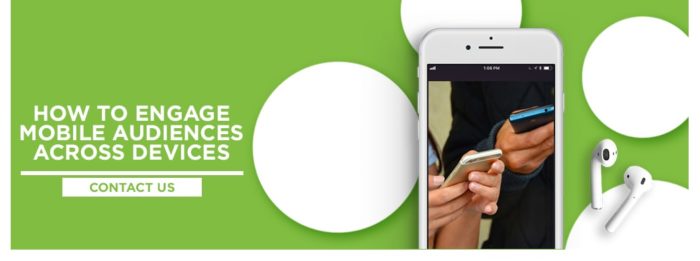
Jump to:
- The Challenges of a Mobile World for Publishers
- How Can Publishers Respond to the Shift to Mobile?
- How to Create Mobile-Friendly Content
- How to Write Content for Mobile
- How to Engage Mobile Audiences Across Devices
Not that long ago, publishers only had to consider desktop when creating digital content. Today, however, readers consume content on a variety of devices — many of them mobile. While the global shift to mobile presents some challenges to publishers, it also provides opportunities. Publishers who don’t take advantage of mobile are missing out on a significant portion of potential subscribers and site visitors, as well as substantial revenue opportunities.
The share of web browsing users do on mobile devices has been growing consistently since 2009. In 2016, global mobile browsing surpassed desktop browsing for the first time, and mobile’s popularity continues to increase today. Using apps is even more popular than web browsing on mobile devices, accounting for 84.9 percent of total time spent on these devices.
Ad spending is, predictably, following traffic to mobile devices. By 2020, analysts forecast mobile will make up 43 percent of total media ad spending in the U.S., more than all traditional media combined.
Publishers can’t afford to ignore the move to mobile. They need to have a mobile strategy — even a mobile-first strategy. Read on for tips on how to respond to this global shift.
The Challenge of a Mobile World for Publishers

Before developing and implementing strategies for reaching people via mobile, it’s helpful to have an understanding of the hurdles living in a mobile-focused world creates for publishers. When you realize what you’re up against, you’re better equipped to overcome them and even transform them into opportunities. Some of these challenges include the following.
- Different usage patterns: Mobile devices provide different user experiences than desktop computers do, and people exhibit different usage patterns when using mobile devices than they do when using desktops. Publishers need to adapt to these changes, meaning they must come up with new strategies for connecting with their audiences. For example, attention is typically more fragmented on mobile devices. People pull out their phones while they’re doing other things such as standing in line, cooking dinner or even consuming other types of media. That means publishers need to try even harder to get readers’ attention quickly and provide them with easily digestible bits of information.
- Different formats: There are also technical differences between smartphones and desktops that publishers need to account for. The size of the screen is a significant change, and some technologies might not work as smoothly on mobile devices. They also make new capabilities, such as GPS, available for publishers to take advantage of.
- More complex targeting considerations: The introduction of mobile also added another level to the choices publishers need to make when targeting ads to their audiences. Not only do they know they need to consider which readers to focus on with which types, but they now also need to think about which devices to target these users on.
- The challenge of multiple devices: Another factor that makes targeting more complicated is the fact that many users have multiple devices. For example, most people have both a computer and a smartphone, and some also have a tablet. To provide cohesive user experiences, publishers need to know these numerous devices belong to the same person. Otherwise, they may treat them as three separate users, creating disjointed content experiences and ad campaigns. Lotame’s Cross-Device technology can help publishers determine the relationships between devices.
How Can Publishers Respond to the Shift to Mobile?

So, how should publishers handle the challenges of shifting to mobile? Here are four steps to take.
- Build an app: Developing a mobile app is an excellent way to reach people on their devices. People typically use apps more than they browse the web on mobile devices, and mobile apps represent 57 percent of all digital media usage. You can also send people notifications and allow people to personalize their in-app experiences.
- Optimize your website: Some users will, however, access your website on mobile. You need to make sure your site looks good and is easy to use on mobile by using a responsive design that adapts automatically to the size of the screen on which users view it.
- Create mobile-friendly content: To reach people wherever they are, you need to develop content and copy with mobile users in mind. We’ll discuss strategies for doing this in the next section.
- Develop a cross-device strategy: You will also need a plan for how you’ll reach users across their various devices. Lotame’s Cross-Device solution can help with this.
How to Create Mobile-Friendly Content

If you’re a publisher, how can you go about creating mobile-friendly content? Here are several tips for developing content that performs well on mobile so you can better reach users on all their devices.
- Increase site speed: Having a quick load time for your web pages is always essential, but it’s especially crucial on mobile devices. Users are on the move, and they typically don’t want to invest large chunks of time in waiting for a website to load. A user will leave a page that takes more than three seconds to load 53 percent of the time. To speed up your site, simplify its design, remove unnecessary code, minimize redirects and optimize images by compressing them. You can also turn on browser caching, so devices remember your pages and load them faster when users revisit them.
- Make the essential information easily visible: On mobile, you’re working with a much smaller screen, so you need to make sure the critical information is immediately noticeable. According to an eye-tracking study by Briggsby, mobile users give 68 percent of their attentionto the center and top half of their screen, and 86 percent to the top two-thirds. Make sure the information you most want to convey appears on these parts of the screen. It’s also helpful to ensure each page has only one central focus. When creating forms, keep data entry requirements to a minimum, since users are less likely to spend the time needed to fill in lengthy forms on mobile.
- Avoid clutter: Viewing content on the small screen of a smartphone amplifies the negative impact of cluttered design. Remove any unnecessary elements so users can scan your content and quickly get the information they need. To make your content more scannable, use easy-to-read fonts and break text up with images. Surround each element with plenty of open space, too.
- Provide content in various formats: Written material can perform well on mobile, but it’s helpful to vary what you publish. Users prefer different content formats, so giving your audience options will attract more visitors. Also, research shows our eyes are more drawn to visualsthan text. Infographics, videos and interactive tools all perform well on mobile. You don’t have to make all your content into visual form, but try taking some of your top-performing articles and creating a video or infographic version of them.
- Take advantage of the functionality of mobile devices: Smartphones offer a variety of features other devices don’t have. Take advantage of these capabilities when creating your content and strategies. See if you can incorporate GPS, SMS and the camera functionality into your content. The ability to send push notifications is especially useful. Use a data management platform (DMP) to collect user data, create user profiles and define audience segments. Then, use this information to send personalized notifications to people based on their usage patterns and interests. These messages will grab their attention and bring them back to your app at optimal times.
- Make navigation easy and intuitive: It’s essential to make your content easy to navigate on mobile. Because of the smaller screens of mobile devices, many designs that look good on a desktop won’t work on mobile. That’s why it’s crucial to design with smartphone users in mind. Remember, people are using touchscreens when interacting with your content. If you have clickable links, make sure the link or button is large enough that users can easily press it with one finger.
- Regularly test your design on mobile: You need the design of your content to work well on mobile devices and be responsive. It should look good on all types of devices, as well as in both portrait and landscape orientation. Use responsive design principles, but also be sure to test your site to make sure it works. Regularly access your site using various mobile devices to ensure everything remains optimized for all screen sizes. You can also ask for user feedback about your mobile site.
How to Write Content for Mobile
There are also some strategies you can use when writing the copy for your content that will help it perform well on mobile. Try these mobile copywriting tips.
- Use short and catchy headlines: Your headline is crucial for getting people to click on your story, and on mobile, it’s especially important to make your title concise and intriguing. Longer headlines get cut off on mobile screens, so make them as short as possible while still getting your point across. Make sure users can grasp the idea behind your headline with just a quick scan. Of course, you also want your headline to grab people’s attention and make them want to read your article. It’s also smart to put a “hook” in the first few lines of your article that will compel readers to read the rest.
- Create scannable content: The best mobile content is scannable. You want people to be able to quickly scroll through your content and be able to get the main ideas behind the article. Write in short paragraphs, break your text up into sections using subheads and include bulleted or numbered lists. Using lists can also help you get featured in Google’s answer boxes, which appear at the top of search engine results pages.
- Keep content to the point: People can’t see as much content at one time on smartphone screens, and they’re also more likely to get distracted when using a mobile device. For these reasons, it’s crucial to keep your content to the point when writing for mobile. Keep each article focused on one topic, and make sure your main ideas are easy to find. You could even include a summary of the essential information at the beginning or end of each piece of content. That way, if readers only want a quick overview, they have that option and won’t click away for something briefer from another publisher.
- Use casual, concise and easy-to-read language: You can even optimize the kind of language you use for mobile. Use language that’s approachable and easy to understand. Don’t use large words or multiple words when one small word will do. Using a familiar word is also better than using one a reader might have to stop and look up, interrupting their experience and possibly taking them away from your site or app. Writing concisely doesn’t necessarily mean you need to write short posts, but avoid making your articles longer than they need to be. You can use the Hemingway app to check how easy your text is to read.
- Create content that’s valuable to your audience: Of course, you always want to make content that aligns with your audience’s interests and provides them with meaningful takeaways. Often, people will read an article with a specific goal in mind. Using the tips above, make it easy for people to find the answer they’re looking for.
How to Engage Mobile Audiences Across Devices

It’s crucial to meet your audience where they are. In today’s world, they have many choices, thanks to the shift to mobile as well as the introduction of tablets, wearables and other devices. Publishers need to reach their users across various platforms to create more engaging content experiences and more successful ad campaigns.
To do this, you need to be able to determine which devices belong to which users. Lotame’s Cross-Device technology accomplishes this using probabilistic and deterministic matching. Probabilistic matching refers to analyzing the signals flowing from devices to determine possible relationships between them. Deterministic matching uses information that directly connects devices, such as login information from apps and websites.
Publishers can use this information to create cross-device audiences and serve them content customized to their interests and habits, no matter what device they’re using. They can customize ads in the same way. It also enables publishers to deliver sequential messaging across devices. Publishers can serve readers ads and content that help them move through the sales funnel, either to become a subscriber to the publisher’s site or to improve campaigns for advertisers placing ads on their site. Being able to reach a user across multiple devices makes it easier to connect with them at the optimal time to create a conversion. Publishers can also feed cross-device data into their DMP and pass third-party data through their cross-device technology to expand their audiences.
Want to learn more about how Lotame’s Cross-Device technology and DMP can help you to better engage your audience across devices? Contact us or request a demo today. We’d love to hear from you.


